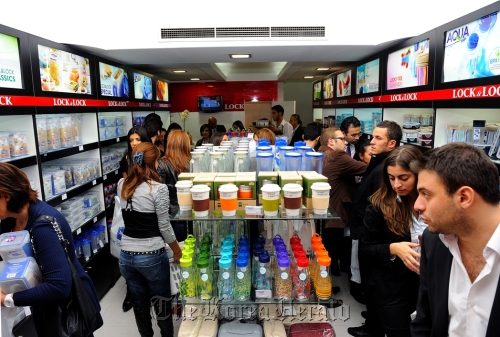Lock&Lock aims to become global No. 1 in airtight containers by 2013
This is the fourth installment of a series that spotlights Korean products enjoyed by people abroad. ― Ed.
In June 2002 many foreigners, including college students, visited the country to watch the World Cup soccer games co-hosted by Korea and Japan.
What caught the eyes of locals were the plastic boxes they used to carry food such as snacks and nuts ― the food container of Lock&Lock, a Seoul-based kitchenware maker.
“Many of them were overseas students. They brought our products sold abroad as souvenir for their mother,” said Kim Jeong-hoon, a spokesperson for Lock&Lock.
“Until then, Korean consumers thought it was a product of a foreign brand and became curious about the product,” he said, describing the period as a “major breakthrough.”
Kim Joon-il, the founder of Lock&Lock, used to import plastic home appliances from Japan since 1978. He then started producing the company’s own products in 1985, which led to the 1998 launch of a plastic food container brand “Lock&Lock.”
The plastic box that has four hinged wings on the lid has become a huge success globally now. The then unusual design originated from the Korean eating habit that stores kimchi, soups and other wet foods in the fridge for days or even months.
At first consumers who were familiar with American brands such as Tupperware and Rubbermade showed little interest in the “ugly products,” said Kim.
But in an international exhibition in 1998, a Canadian buyer saw a Lock&Lock official who was catching and throwing a container full of water.
“He was just killing time at the empty booth. But the buyer was impressed by the airtight function,” said Kim.
This is the fourth installment of a series that spotlights Korean products enjoyed by people abroad. ― Ed.
In June 2002 many foreigners, including college students, visited the country to watch the World Cup soccer games co-hosted by Korea and Japan.
What caught the eyes of locals were the plastic boxes they used to carry food such as snacks and nuts ― the food container of Lock&Lock, a Seoul-based kitchenware maker.
“Many of them were overseas students. They brought our products sold abroad as souvenir for their mother,” said Kim Jeong-hoon, a spokesperson for Lock&Lock.
“Until then, Korean consumers thought it was a product of a foreign brand and became curious about the product,” he said, describing the period as a “major breakthrough.”
Kim Joon-il, the founder of Lock&Lock, used to import plastic home appliances from Japan since 1978. He then started producing the company’s own products in 1985, which led to the 1998 launch of a plastic food container brand “Lock&Lock.”
The plastic box that has four hinged wings on the lid has become a huge success globally now. The then unusual design originated from the Korean eating habit that stores kimchi, soups and other wet foods in the fridge for days or even months.
At first consumers who were familiar with American brands such as Tupperware and Rubbermade showed little interest in the “ugly products,” said Kim.
But in an international exhibition in 1998, a Canadian buyer saw a Lock&Lock official who was catching and throwing a container full of water.
“He was just killing time at the empty booth. But the buyer was impressed by the airtight function,” said Kim.

Then in the same year the company entered the U.S. market through home-shopping channel QVC and consumer response was positive.
Coupled with the popularity earned during the World Cup, the company has grown quickly over the past 10 years.
The company has 22 overseas corporations, with 5,365 employees, including 4,186 foreign workers. It logged 380 billion won ($322 million) in sales last year and this year is expected to see 500 billion won.
Now the company aims to become No. 1 food container maker by raising its current 11.7 percent of global market shares to 17.8 percent by 2013.
The perfect airtight seal would be the most important reason for such a global popularity. Another factor is the variety of more than 2,000 types of products designed to meet different and new demands from consumers around the world.
In China where people like to sip tea wherever they go, a long container that separates water from the teabag is a bestseller. A salad bowl which has several sections for ingredients and sauce is an exclusive item for American consumers who enjoy picnics.
For German consumer Christine Vondran, Lock&Lock is used as a gift box for holidays.
“For holidays such as Christmas, I put home-made cookies, candies and cakes into the Lock&Lock box and give it to my relatives with a thank-you note. They love it,” the Frankfurt resident said via email.
In January 2010, the company was listed on the Korean stock market, becoming one of the blue-chip stocks that are expected to benefit from soaring Chinese demands.
“China, of course, is our growth engine. We also focus on the growing Southeast Asian and South American markets as a premium brand,” Kim said.
“In the end, we would become a global total living brand,” he said.
With food containers making up only 30 percent of the company sales, it produces a wide range of products from cookware and bath items to accessories for outdoor activities.
By Lee Ji-yoon (jylee@heraldcorp.com)



![[Herald Interview] 'Amid aging population, Korea to invite more young professionals from overseas'](http://res.heraldm.com/phpwas/restmb_idxmake.php?idx=644&simg=/content/image/2024/04/24/20240424050844_0.jpg&u=20240424200058)













![[KH Explains] Korean shipbuilding stocks rally: Real growth or bubble?](http://res.heraldm.com/phpwas/restmb_idxmake.php?idx=652&simg=/content/image/2024/04/25/20240425050656_0.jpg&u=)

